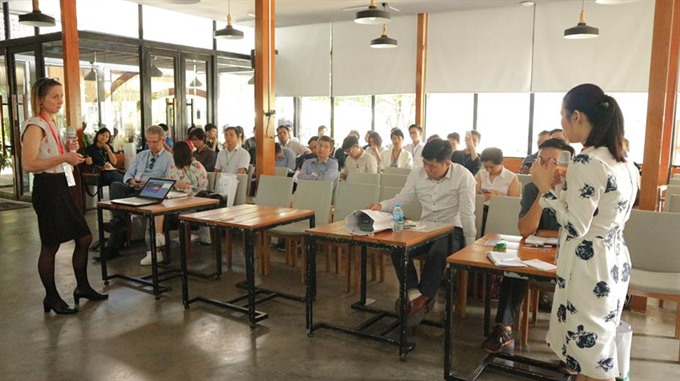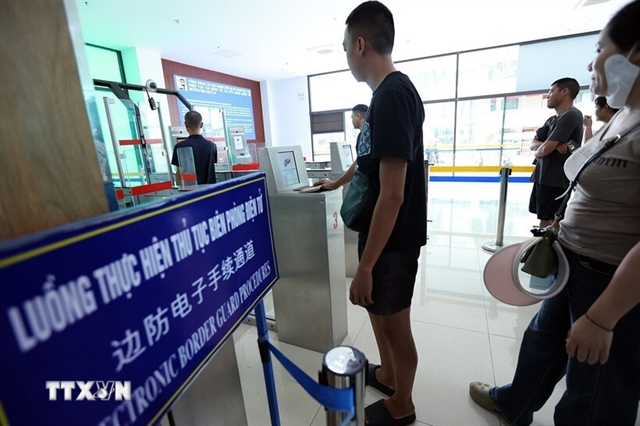 Economy
Economy

Digital technology and online connectivity will be a driving force for the growth and transformation of the Vietnamese economy in the coming decades, a workshop heard in HCM City.
 |
| Digital technology and online connectivity will be a driving force for the growth and transformation of the Vietnamese economy in the coming decades.– Photo vtc.vn |
HCM City – Digital technology and online connectivity will be a driving force for the growth and transformation of the Vietnamese economy in the coming decades.
“Technology revolution and digitisation have gradually changed the Vietnamese socio-economy,” Lucy Cameroon, head of the ongoing “Việt Nam’s Future Digital Economy” project said.
“Clearly understanding digital trends would help Việt Nam grasp opportunities and limit risks. This is a good chance for Việt Nam to prepare for a breakthrough.”
The project is aimed at making strategic predictions about Việt Nam’s digital economy in the next 20 years.
At the workshop, which was held in HCM City on Wednesday, four possible scenarios for the country’s digital economy were discussed.
In the first scenario, there will be little change. There will be low digital transformation and digital adoption and productivity.
There will be a failure to reform by the Government and industry to prepare for new technologies and the digital disruption.
There will be regular cyber-attacks on the country’s ICT networks and banking and other sectors. Regular data breaches and hacking will increase consumer distrust in electronic networks and systems, resulting in the growth of the informal economy and increase in the use of cash.
Flatlining labour productivity will cause some of the larger factories producing high-technology goods to move offshore to take advantage of industry 4.0 technologies and cheap, reliable and clean sources of power.
Factories closing or replacing staff with automated systems in all sectors will create high unemployment, particularly in regional and rural areas, and this will negatively impact crime, personal safety and the liveability of cities.
The speed of urbanisation will increase, infrastructure will be inadequate, the quality of life in urban areas will be lower, and energy will be unreliable.
Lack of effective monitoring and control of environmental pollution will degrade land, air and water.
In the second scenario, there will be digital transformation, digital adoption and high ICT industry growth, and labour productivity will increase across all sectors.
Digital adoption is widespread across the population and industrial sectors, resulting in inclusive growth.
The country’s main exports will be knowledge-based services, especially in design, digital services, agricultural technologies, and advanced manufacturing.
For this scenario to occur, there needs to be investment in education, new energy sources, a national innovation network, and safe and secure communications networks.
There should be focus on cyber security and widespread deployment of new networks to enable IoT while building broad proficiency in writing code and centres of excellence in ICT growth industries.
Introduction of a digital currency for Việt Nam and associated apps is needed.
Việt Nam’s export industries will have transformed and become knowledge-intensive. Việt Nam will be one of Asia’s ‘tiger’ economies and on the verge of becoming a high-income nation.
The digital economy will boom in terms of both supply for internal projects and also exports of ICT products and services
In this scenario, Việt Nam will be a world leader in ICT, have better logistics facilities and benefit from a brain gain. Urban areas will use clean fuels and have clean air and high liveability, people will travel by metro and autonomous vehicles in smart cities and can work from anywhere.
In the third scenario, Việt Nam is a digital exporter. Its ICT industry will grow based on outsourcing from other countries, but internal adoption of digital technologies across industries will remain low though without significantly impacting labour productivity.
Economic growth in Việt Nam is no longer inclusive, but largely restricted to a few privileged enclaves in main export sectors like ICT products and services commissioned by external companies, agriculture, tourism.
Việt Nam will still be a low-cost labour market and specialise in IT outsourcing and ICT manufacturing.
Adoption of new technologies will be hampered by fears of rapid change, lack of regulatory reforms, lack of cyber security across the telecommunications networks, and low investment in testing and industry modernisation incentives.
Patent protection will have improved but still not apply to many ICT products and software.
The national innovation system will not be mature, and so innovation, foreign aid for innovation and technical developments will be opportunistic and unco-ordinated to meet the needs of external players rather than used in a co-ordinated way to achieve Việt Nam’s goals.
Việt Nam’s cities will be growing and becoming more geographically distinct, with richer and poorer areas becoming clearly demarcated.
The richer areas within the urban environments will have greater opportunities and access to jobs and training than poorer areas, which have grown on the outskirts of major metropolitan centres.
There will be areas of high crime, and these areas will increase their use of the informal economy even while other areas reduce it.
Although systems for environmental monitoring will improve, this will not translate into a high degree of on-the-ground resilience.
In the fourth scenario, the industry will use ICT goods and services from other countries and improves productivity across all sectors.
Digital adoption across all industry sectors will be high, and this will have a positive impacts on labour productivity.
Industrial transformation will be broad but expensive due to the import of technologies and platforms.
In exports, productivity will increase but there will be a limited change in market composition
Investment in ICT hardware manufacturing will grow and 90 per cent of factories and logistics processes will be automated.
The ICT sector will grow, but there will also be growth in other sectors to match it. The ICT industry will remain centred on hardware manufacturing rather than new products or software.
Most of the technologies used to improve labour and productivity and modernise industry will be imported. This means Việt Nam will have only second-mover advantage, saving some costs associated with ICT development but paying external companies more for their services over the longer term.
Using only external products, services and platforms will also mean that other countries collect and analyse a lot of data on Vietnamese businesses and citizens.
Innovation will be focused on modernising industry. Industry incentives like grants for smart specialisation, tax breaks, guidelines on FDI, and innovation rewards will create rapid change, first in manufacturing then in agriculture.
Investment in a national innovation system will focus heavily on industry partnerships and the adoption rather than the development of new technologies.
There will be co-ordinated roll-outs of 5G and IoT networks and this will result in the development of smart city infrastructure and use of sensor networks across much of the country.
Life in urban areas will change significantly with the use of smart city infrastructure and the introduction of AI to monitor and control everything from waste collection and traffic flows to emergency response units and crime.
The programme is being carried by the Ministry of Science and Technology and Australian Data 61 under the Australian Embassy’s Aus-4Innovation programme.
It was started in January 2018 and will finish next March. — VNS

.jpg)


